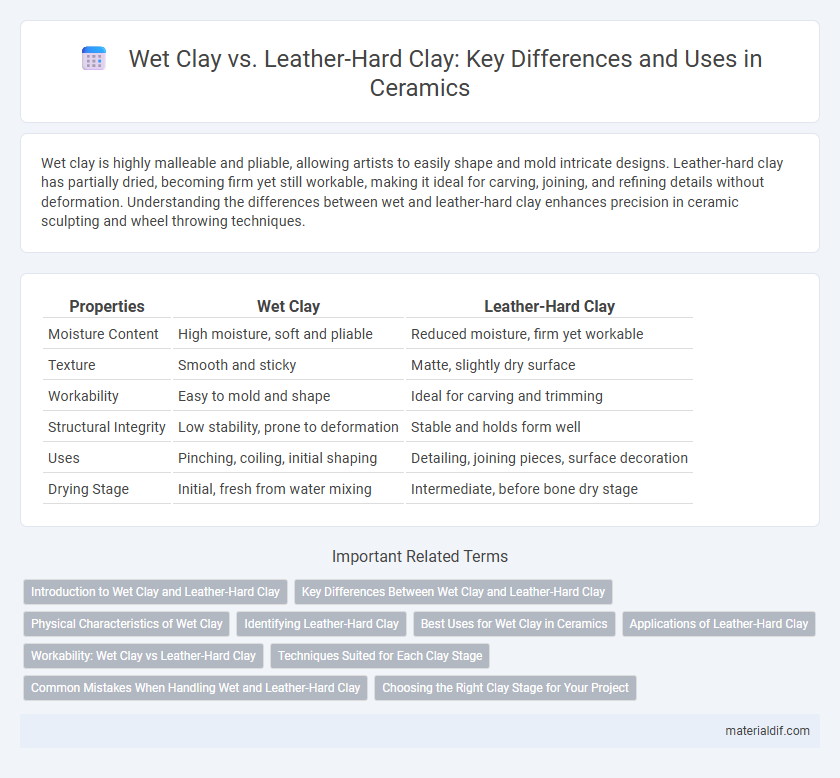Wet clay is highly malleable and pliable, allowing artists to easily shape and mold intricate designs. Leather-hard clay has partially dried, becoming firm yet still workable, making it ideal for carving, joining, and refining details without deformation. Understanding the differences between wet and leather-hard clay enhances precision in ceramic sculpting and wheel throwing techniques.
Table of Comparison
| Properties | Wet Clay | Leather-Hard Clay |
|---|---|---|
| Moisture Content | High moisture, soft and pliable | Reduced moisture, firm yet workable |
| Texture | Smooth and sticky | Matte, slightly dry surface |
| Workability | Easy to mold and shape | Ideal for carving and trimming |
| Structural Integrity | Low stability, prone to deformation | Stable and holds form well |
| Uses | Pinching, coiling, initial shaping | Detailing, joining pieces, surface decoration |
| Drying Stage | Initial, fresh from water mixing | Intermediate, before bone dry stage |
Introduction to Wet Clay and Leather-Hard Clay
Wet clay is highly malleable and retains significant moisture, making it ideal for initial shaping and molding in pottery and sculpting. Leather-hard clay has partially dried, becoming firm yet still workable, allowing for carving, refining edges, and attaching pieces without deformation. Understanding the moisture levels in clay stages is crucial for controlling texture and structural integrity during the ceramic process.
Key Differences Between Wet Clay and Leather-Hard Clay
Wet clay contains the highest moisture content, making it soft, pliable, and ideal for shaping and molding, while leather-hard clay has lost some moisture, becoming firm yet still workable for carving, trimming, and attaching pieces. Wet clay is more fragile and prone to collapsing under weight, whereas leather-hard clay provides better structural support and is less sticky to the touch. The drying process transitions clay from wet to leather-hard, significantly impacting handling techniques and the stage at which surface details can be added.
Physical Characteristics of Wet Clay
Wet clay exhibits a soft, malleable texture with high plasticity, allowing easy shaping and molding without cracking. It contains abundant moisture, making it pliable and sticky to the touch while maintaining a smooth surface. The physical characteristics of wet clay enable artists to manipulate fine details and join pieces seamlessly before it transitions to the leather-hard stage.
Identifying Leather-Hard Clay
Leather-hard clay is characterized by a firm yet slightly flexible texture, making it ideal for carving and attaching pieces without deformation. Unlike wet clay, which is soft and malleable, leather-hard clay holds its shape while retaining enough moisture to allow for detailed shaping and surface treatments. Recognizing leather-hard clay by its stiff feel and matte surface enables potters to prevent cracking during drying and ensures optimal workability for construction and decoration.
Best Uses for Wet Clay in Ceramics
Wet clay, rich in moisture content, is ideal for hand-building techniques such as coiling, pinching, and slab construction due to its pliability and ease of manipulation. It allows artists to join pieces seamlessly and create intricate details before drying begins, making it indispensable for sculptural work and wheel throwing preparation. Wet clay's plasticity also supports surface texturing and embossing, enhancing the aesthetic quality of ceramic forms.
Applications of Leather-Hard Clay
Leather-hard clay is ideal for sculpting precise details, joining ware, and trimming excess material due to its firm yet malleable texture. This stage of clay development provides sufficient strength to support carving and adding attachments without deforming the overall shape. Artists often exploit leather-hard clay for hand-building techniques, slab construction, and creating sharp edges that hold during drying and firing.
Workability: Wet Clay vs Leather-Hard Clay
Wet clay offers superior plasticity, making it highly malleable and ideal for shaping or molding intricate details. Leather-hard clay, with its partial drying, maintains enough moisture to be carved or joined while providing structural firmness that resists deformation. Choosing between these stages depends on the required flexibility for sculpting versus the stability needed for refining and assembly.
Techniques Suited for Each Clay Stage
Wet clay, with its high moisture content, is ideal for hand-building techniques such as pinching, coiling, and slab construction, allowing easy shaping and joining of pieces. Leather-hard clay, partially dried but still pliable, suits carving, trimming, and adding intricate details or handles, as it holds shape better without collapsing. Each stage requires specific tools and pressure levels to maintain structural integrity and achieve desired textures in ceramic projects.
Common Mistakes When Handling Wet and Leather-Hard Clay
Common mistakes when handling wet clay include overworking the material, which leads to structural weakness and cracks during drying or firing. In contrast, mishandling leather-hard clay often involves attempting to reshape it too aggressively, causing unintended fractures or warping. Proper timing and gentle manipulation of both wet and leather-hard clay stages are essential to maintain optimal plasticity and structural integrity.
Choosing the Right Clay Stage for Your Project
Wet clay offers maximum plasticity, allowing easy shaping and molding, which is ideal for intricate or highly detailed projects. Leather-hard clay, partially dried but still workable, provides greater structural stability and is perfect for carving or attaching pieces without deformation. Selecting the right clay stage depends on project requirements: choose wet clay for flexibility and leather-hard for precision and strength.
Wet clay vs Leather-hard clay Infographic

 materialdif.com
materialdif.com